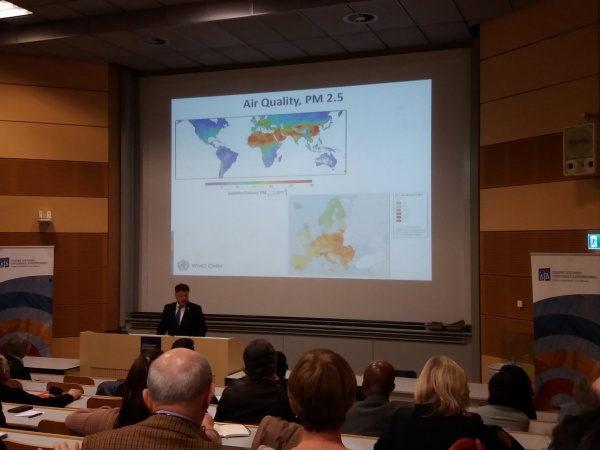Climate Change and Disasters
Jessica Belmonte , 25 février 2020

On 18 February 2020, Prof. Petteri Taalas, Secretary General of the World Meteorological Organization held a conference at the University of Geneva on “Climate Change and Disasters”.
Prof. Taalas started by presenting the WMO. It is a specialized agency of the United Nations with 193 Member States and Territories. It represents the UN system’s authoritative voice on behavior in terms of weather, climate and water. The Organization plays a leading role in international efforts to monitor and protect the environment through its actions. WMO programs facilitate and promote the application of science and technology in operational meteorology, to coordinate the research and training in climate observation fields. Moreover, the WMO standardization instruments provide a comparative approach of each member’s data in accordance with the organization standards and forecast.
In his speech, Prof. Taalas made it clear that today the effects of climate are closely linked to the disasters’ apparition. The most critical impacts of these environmental hazards are, in his view, water and weather changes. Between the period of 1998 and 2017, there are approximately 4.5 billion of people, which were affected by climate change and heatwave. This created 96% of disasters such as flood, drought, storm, earthquake, extreme temperature, landslide, wildfire, etc. The hurricane Katrina could be considered one the worst environmental hazard so far. Indeed, in term of casualties, there could be noted economy loses for the target countries. This negative relation was expressed through the substantially GDP decrease and continuous increase of mortality in the affected states.
On another note, the Secretary General choose to undermine some of the consequences of today and those expected in the near future if we do not try to find solutions and to change our way of living. Considering the WMO’s 2019 annual report, the temperature increases with about 1.1° C since 1850. The effects of global warming are more critical in the Arctic region, as the warming process is having a rate of almost twice than the global average. Indeed, between 1950 and 2018, the melting of global glaciers is increasing. Those facts are related to heating process of the ocean content, which results to sea level rise. Additionally, in the new record on the greenhouse gas emissions, notably from energy production, industry and transport, the CO2 emission contributes to 66 % of warming.
Furthermore, one of a global problem is precipitation, which is related to drier climate, particularly we can notice it in the African region. In parallel, in Australia the same observation is noticeable, because Australia suffers from devastating bushfires, which contribute to CO2 emission. Hence, the precipitation issues obviously affect human health and nature.
We can observe the amount of consequences on health, such as hunger due to the shortage of resource and unproductivity yield, alongside daily apparent risks such as serious disease due to pollution and air quality. Especially in places where industries are planted, which are the worst in term of air quality.
There are studies that show that 3°C warmer world would be a major risk for food security, and there would be loss of crop yield in most parts of the world and according to the Prof. Taalas, it is a major risk for climate change. This is also related to water availability, which would be a major issue due to drier region, along with the major population growth expected by 2050.
But if we tend to reduce emissions of production, we can improve air quality. This is what countries of Western Europe currently try to focus on. Indeed, those problems are very challenging and relate also to consumption, consumers, ressources issues.
The challenge nowadays is concentrated on energy, how to use industries? How to become carbon neutral by 2050? This is a project of the European Union, and there was some changes in annual global energy demand between 2011 and 2018.
According to Prof. Taalas, to solve those problems, we need global actions. It is a common effort. Indeed, climate change is already visible, and it is a priority for several protagonists such as international organizations, citizens, private and public enterprises, governments. Technical and economy means to control the impact on climate change already exist. For example, on transport, energy, and bio economy but the challenge is for fossil businesses.
To conclude, Prof. Taalas lists some important challenges such as the general political acceptance, as well as the 1,5° C target. Investment in climate adaptation is required and private enterprises, such as Amazon, start investing in environment projects. But means to control population growth are also necessary, especially toward African population.
But according to Prof. Taalas, there is too much panic on youth activism, WMO do not foresee the end of the world but it is a serious issue that have to be taken for consideration. Nevertheless, fear and panic is not necessary. The most important is to take actions. The Secretary General compared the situation with when he was a student in the early 80s: all students panicked about the nuclear issue. It is normal that students are revolted about climate change but we cannot let fear surround us. We should rather change our daily behavior for a better transition.
The relevant outcome, forecast and activism that Prof. Taalas conveys us, left the conference’s room full of interest and some issues to think about to avoid the less disasters possible that climate change can bring on the planet and living being.
Jessica BELMONTE, Climate Change and Disasters, actualité du CEJE n° 7/2020, disponible sur www.ceje.ch.

